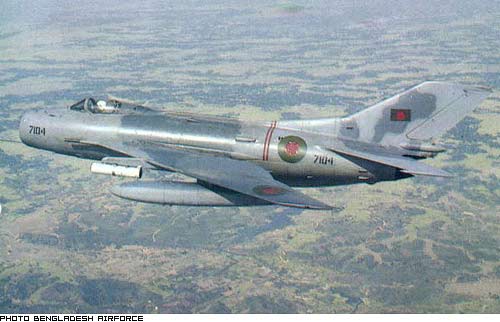MiG-19 Farmer
Summary
| Category | Combat Aircraft |
| Origin country | 🇨🇳 Ex-USSR |
| Manufacturer | Mikoyan-Gurevitch |
| First flight | 18 September 1953 |
| Year introduced | 1955 |
| Number produced | 2172 units |
| Average unit price | $2 million |
Description
From the introduction of the MiG-17 Fresco, Soviet aircraft manufacturers began working on a new generation of fighters capable of reaching and sustaining supersonic speeds in horizontal flight. This led to the development of the MiG-19 Farmer.
The MiG-19 displayed excellent performance, surpassing that of the F-100 Super Sabre. However, early versions suffered from significant reliability issues. Its landing was treacherous, control at supersonic speeds was difficult, and poor fuel tank insulation caused mid-air explosions. Most of these flaws were discovered during test flights, but due to the urgent need for production, they were later rectified on in-service aircraft.
In 1956, an improved version called the MiG-19S Farmer-C entered service in the Russian Air Force. The MiG-19S underwent several aerodynamic modifications to enhance stability and was equipped with a longer-range "Svod" radar. The MiG-19S was quickly replaced by the MiG-19P version, featuring an "Izumrud" radar that required modifications to the nose of the aircraft and the removal of one of its three cannons. Not only was this radar unreliable, but its installation also diminished the aircraft's performance and cockpit visibility.
The MiG-19 Farmer's armament varied depending on the version and could consist of two or three highly effective NR-23 or NR-30 cannons, as well as rocket pods, bombs, and later on, K-13 / AA-2 Atoll Sidewinder air-to-air missiles. The MiG-19 proved its capabilities in combat during the later stages of the Vietnam War against American fighters.
However, the MiG-19 gained a poor reputation among Soviet pilots, which led to its replacement by the iconic MiG-21 Fishbed. Nevertheless, China produced approximately 3,000 MiG-19 aircraft under license at the Shenyang workshops, designated as the J-6. Some J-6 aircraft were exported and designated as F-6. The MiG-19 remained in service for a considerable period in countries of the former Warsaw Pact.
Technical specifications
| Version: MiG-19S Farmer-D | |
|---|---|
| Crew | 1 pilot |
| Maximum speed | 1455 km/h (904 mph) |
| Wing area | 25.2 m² (270.8 sqft) |
| Wingspan | 9.2 m (30.2 ft) |
| Height | 3.9 m (12.7 ft) |
| Length | 12.5 m (41.1 ft) |
| Service ceiling | 17,500 m (57,415 ft) |
| Empty weight | 5,447 kg (12,009 lbs) |
| Max. takeoff weight | 8,832 kg (19,471 lbs) |
| Climb rate | 180.0 m/s (590.6 ft/s) |
| Takeoff distance | 900 m (2,953 ft) |
| Powerplant | 2 x turbojets Tumansky RD-9B delivering 2600 kgf each |
| Ejection seat | Severin KS-1 |
Current operating countries
| Country | Units | ||
|---|---|---|---|

|
North Korea | 97 | |

|
China | 14 | |

|
Bangladesh | 9 | |

|
Pakistan | 9 | |

|
Sudan | 8 | |

|
Tanzania | 3 | |

|
Myanmar | 1 | |
All operators
Armament
Missiles payload:
- Air-to-Air Short-Range Vympel R-3 (AA-2 Atoll)

